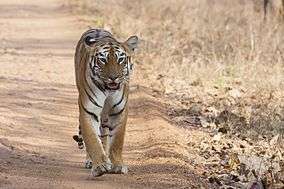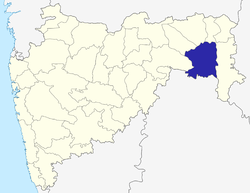Tadoba Andhari Tiger Project
| Tadoba Andhari Tiger Project ताडोबा राष्ट्रीय उद्यान | |
|---|---|
|
IUCN category II (national park) | |
|
Maya of Tadoba walks on the road | |
 | |
| Location | Chandrapur district, Maharashtra, India |
| Nearest city | Chandrapur 40 kilometres (25 mi) E |
| Coordinates | 20°10′0″N 79°24′0″E / 20.16667°N 79.40000°ECoordinates: 20°10′0″N 79°24′0″E / 20.16667°N 79.40000°E |
| Area | 625.4 square kilometres (241.5 sq mi) |
| Established | 1955 |
| Governing body | Maharashtra Forest Department |
| Website |
mahatadobatiger |
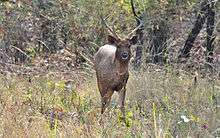
Tadoba Andhari Tiger Reserve is a tiger reserve in Chandrapur district of Maharashtra state in central India. It is notable as Maharashtra's oldest and largest national park. It is one of India's 43 "Project Tiger" - tiger reserves.[1]
Etymology
The name "Tadoba" is the name of the God "Tadoba" or "Taru", praised by the tribal people who live in the dense forests of the Tadoba and Andhari region, while the Andhari river that meanders through the forest. gives the 'Andhari' name.[2]
History
Legend holds that Taru was a village chief who was killed in a mythological encounter with a tiger. A shrine dedicated to the God Taru now exists beneath a huge tree, on the banks of the Tadoba Lake. The temple is frequented by adivasis, especially during the fair held every year in the Hindu month of Pausha, between December and January.
The Gond kings once ruled these forests in the vicinity of the Chimur hills. Hunting was completely banned in 1935. Two decades later, in 1955, 116.54 km2 (45.00 sq mi) was declared a National Park. Andhari Wildlife Sanctuary was created on the adjacent forests in 1986, and in 1995, both the park and the sanctuary were merged to establish the present tiger reserve.[2]
Topography
Tadoba Andhari Reserve is the largest national park in Maharashtra. Total area of the reserve is 1727 km2. This includes Tadoba National Park, created in 1955.
Tigers at Tadoba
There are 88 tigers, as of August 2016 in the reserve, and 58 in the forests immediately outside the reserve.[3]
Tadoba Andhari Reserve
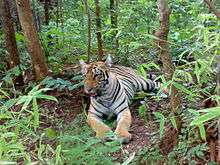
Tadoba Andhari Reserve is the largest national park in Maharashtra. Total area of the reserve is 625.4 square kilometres (241.5 sq mi). This includes Tadoba National Park, created in 1955 with an area of 116.55 square kilometres (45.00 sq mi) and Andhari Wildlife Sanctuary created in 1986 with an area of 508.85 square kilometres (196.47 sq mi). The reserve also includes 32.51 square kilometres (12.55 sq mi) of protected forest and 14.93 square kilometres (5.76 sq mi) of other areas.

Densely forested hills form the northern and western boundary of the tiger reserve. The elevation of the hills ranges from 200 m (660 ft) to350 m (1,150 ft).
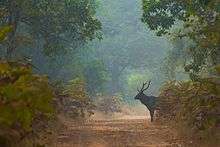
To the southwest is the 120 ha (300 acres) Tadoba lake which acts as a buffer between the park's forest and the extensive farmland which extends up to Irai water reservoir.This lake is a perennial water source which offers good habitat for Muggar crocodiles to thrive.Other wetland areas within the reserve include the Kolsa lake and Andhari river.
Tadoba reserve covers the Chimur Hills, and the Andhari sanctuary covers Moharli and Kolsa ranges. It’s bounded on the northern and the western side by densely forested hills. Thick forests are relieved by smooth meadows and deep valleys as the terrain slopes from north to south. Cliffs, talus and caves provide refuge for several animals. The two forested rectangles are formed of Tadoba and Andhari range. The south part of the park is less hilly. Recently a Photo capture from this reserve by Amol bais posted on Postal stamp to be released on July 29 this year o, World Tiger day.
Threats
There are 41,644 people living in and around the reserve in 59 villages of which 5 are inside the core zone, These villages in the core zone still do farming activity inside the core area. The process of rehabilitation is going on but the Indian bureaucracy has been at its slowest in the forest department.Recently the Navegaon village was rehabilitated and a grassland is expected on the place where the village existed. There are 41,820 cattle with the villagers in the core and buffer zone. While cattle grazing is not allowed in the core zone, regulated grazing in the buffer zone is allowed to cattle of the village inhabitants. However, cattle of peripheral villages sometimes sneak into the reserve and cause additional damage to the habitat. Forest fires are a constant problem in the dry season, consistently burning between 2% and 16% of the park each year.With killing of domestic livestock by tigers and leopards as a frequent phenomenon in the areas neighboring villages. This has an adverse impact on the economic condition of the local people and results in antagonism towards the management. In the year 2013 so far there have been up to 4 people and 30-50 cattle heads killed by leopards, tigers or sloth bears. Densely forested hills form the northern and western boundary of the tiger reserve. The elevation of the hills ranges from 200 m (660 ft) to350 m (1,150 ft). To the southwest is the 120 ha (300 acres) Tadoba lake which acts as a buffer between the park's forest and the extensive farmland which extends up to Irai water reservoir.This lake is a perennial water source which offers good habitat for mugger crocodiles to thrive.Other wetland areas within the reserve include the Kolsa lake and Andhari river.
Tadoba reserve covers the Chimur Hills, and the Andhari sanctuary covers Moharli and Kolsa ranges. It’s bounded on the northern and the western side by densely forested hills. Thick forests are relieved by smooth meadows and deep valleys as the terrain slopes from north to south. Cliffs, talus and caves provide refuge for several animals. The two forested rectangles are formed of Tadoba and Andhari range. The south part of the park is less hilly.[4]
Flora
Tadoba reserve is a predominantly southern tropical dry deciduous forest with dense woodlands comprising about 87 per cent of the protected area. Teak is the predominant tree species. Other deciduous trees include ain (crocodile bark), bija, dhauda, hald, salai, semal and tendu. beheda, hirda, karaya gum, mahua madhuca (crepe myrtle) and Lannea coromandelica (wodier tree) are other common species.
Axlewood (Anogeissus latifolia) is a fire-resistant species growing here. Palas or flame of the forest (Butea monosperma) adds vibrant colour to the forest. Black plum trees grow in the riparian habitat around the lake. At the waterhole at Panchadhara, huge arjun trees are seen.
Patches of grasses are found throughout the reserve. Bamboo thickets grow throughout the reserve. The climber kach kujali (velvet bean) found here is a medicinal plant used to treat Parkinson's disease. The leaves of bheria are used as an insect repellent and bija is a medicinal gum. Beheda is also an important medicine found here.[1][4]
Fauna
Aside from the keystone species, the Bengal tiger, Tadoba Tiger Reserve is home to other mammals, including: Indian leopards, sloth bears, gaur, nilgai, dhole, striped hyena, small Indian civet, jungle cats, sambar, spotted deer, barking deer, chital, chausingha and honey badger. Tadoba lake sustains the marsh crocodile, which were once common all over Maharashtra.
Reptiles here include the endangered Indian python and the common Indian monitor. Terrapins, Indian star tortoise, Indian cobra and Russel's viper also live in Tadoba.
The lake is an ornithologist's paradise with a wide diversity of water birds, and raptors. 195 species of birds have been recorded, including three endangered species. The grey-headed fish eagle, the crested serpent eagle, and the changeable hawk-eagle are some of the raptors.
Other interesting species include the orange-headed thrush, Indian pitta, crested treeswift, stone curlew, crested honey buzzard, paradise flycatcher, bronze-winged jacana and lesser goldenbacked woodpecker. Warblers and the black-naped blue flycatcher exist here and the call of the peacock may often be heard.
74 species of butterflies have been recorded including the pansies, monarch, Mormons and swordtails.
Insect species include the endangered danaid egg-fly and great eggfly. Dragonflies, stick insects, jewel beetles and the praying mantis are other insects located in the reserve.
The signature spider, giant wood spider and red wood spiders are often seen during the monsoon and soon after. Some hunting spiders like the wolf spiders, crab spiders and lynx spiders are also common.[5]
Visitor information
The main attraction of the Tadoba National Park is its jungle safari trips. Open top Gypsy vehicles, buses with trained local guides are available for visitors. Accommodation is also available at various locations.[6]
Getting there
The nearest International Airport is Dr. Babasaheb Ambedkar International Airport, Nagpur (140 km via Umrer, Bhisi and Chimur).
The nearest railway station is Chandrapur (on the Delhi-Chennai main line) 45 km away.
Nearest main bus stand is Chandrapur and Chimur (32 km).
Accommodation
Maharashtra Tourism Development Corporation provides self-contained rooms with adjoining restaurant at Tadoba.
Reservations
Maharashtra Tourism Development Corporation at Mumbai and Nagpur. Deputy conservator of forests and wildlife, Chandrapur[7]
References
- 1 2 "Tadoba-andhari Tiger Reserve", Reserve Guide - Project Tiger Reserves In India, National Tiger Conservation Authority, retrieved 2012-02-29
- 1 2 Tadoba-Andhari Tiger Reserve-History, Sanctuary Asia, retrieved 2012-02-29
- ↑ Mazhar, Ali (2016-08-11). "Problem of plenty hits Tadoba tiger conservation work". Times of India. Retrieved 2016-09-05.
- 1 2 Tadoba-Andhari Tiger Reserve-Habitat, Sanctuary Asia, retrieved 2012-02-29
- ↑ Tadoba-Andhari Tiger Reserve-Wildlife, Sanctuary Asia, retrieved 2012-02-29
- ↑ http://www.amazingmaharashtra.com/2012/10/tadoba-national-park.html Tadoba Jungle Safari
- ↑ http://www.maharashtratourism.gov.in/MTDC/HTML/MaharashtraTourism/TouristDelight/Sanctuaries/Sanctuaries.aspx?strpage=TadobaNPSanctuaries.html
External links
| Wikimedia Commons has media related to Tadoba Andhari Tiger Project. |
- Tiger conservation: Maharashtra villagers get first instalment of rehab package, The Hindu, 29-2-2012
- A Virtual Visit to Tadoba, 2:32, by Kiran G
- Chandrapur-information portal
